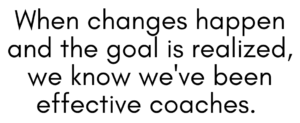Don’t be stymied by these questions. There are solid ways to measure the effectiveness of your coaching. Here are four that are proven to be effective.
#1: Before and after 360s. 360s are commonly used in coaching engagements, especially when coaching leaders. There are two types of 360s. One is the online survey. The online survey we use is called the CheckPoint 360. (If you’d like to see a sample report of the CheckPoint 360, contact us to request it).
This online survey is taken by a group of people in categories such as manager, directs, peers, and others. All of these people contribute anonymously to the 360 except for the manager since there is usually only one person in that category.
You can have your client have a 360 done at the beginning of the engagement and then one after, say, 6 months have elapsed, to measure the effectiveness of the engagement. This is a well established method.
Another type of 360 is called a Verbal 360. At the Center for Executive Coaching, we teach our participants how to use the Verbal 360, and here it is in a nutshell:
You talk to a small group of people one by one who regularly work with your client, and ask them a few prepared questions. You’re simply looking to have a short, focused conversation with these people to uncover patterns of feedback. You will then use the feedback to help your client realize: “If I make these changes, it may accelerate my success towards a targeted outcome.”
The Verbal 360 can be used multiple times throughout the engagement to ensure you’re making progress with the client that is visible to others.
#2: Talk with your client’s manager. The manager is often closely connected with your client and they can sense when your client has made changes and is progressing in the coaching.
Check-ins with the manager usually happen multiple times throughout an engagement, with a typical engagement being six months. Usually, you will get to know the manager at the beginning of the engagement and get feedback from them about changes the client might make. Based on that input and other data sources, the coach and client will create an action plan of what they plan to achieve together in the coaching.
About three months into the coaching, check-in with the manager (with the client also present) and talk about what they’re seeing and gather their feedback about progress. That will sometimes create a mid-course correction for the client, which will put them on a surer trajectory towards their goals. Near the end of the six month engagement, have another check-in with the manager and look for feedback, support and encouragement, and ideas for sustainability in case the engagement is coming to a close.
In short, check-ins with the manager can be very helpful for getting tangible and useful feedback about real progress your client is achieving.
#3: Your client selects a small group of trusted colleagues they can talk to about the changes they’re seeking to make. Typically, this is related to a behavioral change.
Let’s say the client wants to speak last in a meeting. This is something people who attend meetings with your client can note. Each month your client goes to those people and asks them to rate him or her on the effectiveness of the behavioral change. Have they made progress? Did they note they spoke last? On a scale of 1 to 5, with five being the best, what would they give them in terms of their progress towards making this behavior stick?
After this is done for multiple months, your client will have signs of clear progress or prompts to work a little harder. This is also an effective means of measurement because it’s coming from sources outside of your client.
 #4: A specific goal is accomplished. This is a very clear and tangible method. Let’s say your client decides they’d like to be promoted, or they would like to create a better working relationship with their manager. This goal becomes the main focus of the coaching engagement.
#4: A specific goal is accomplished. This is a very clear and tangible method. Let’s say your client decides they’d like to be promoted, or they would like to create a better working relationship with their manager. This goal becomes the main focus of the coaching engagement.
If during the engagement, the goal is reached, that will serve as the benchmark for establishing whether the coaching was effective. This may be the simplest form of measurement, but it’s generally good to have another of the methods used to corroborate the belief that success has been attained except in the case of promotion since that’s a given if it happens.
These are four proven ways for measuring the effectiveness of your coaching. We recommend using two or more of them within an engagement. By ascertaining the impact of your coaching on your clients, you can coach them with confidence and purpose.
If you have questions or comments, please reach out to us via our Contact Form. To learn more about our coach training options, please visit our Enrollment Options page.
Here are more articles and videos related to this article:
Articles
- Demonstrating the ROI of Executive Coaching to Clients and Prospects
- A sure sign of the impact of coaching
- What will take your coaching to the next level?
- 3 proven ways to elevate your skills as an executive coach
YouTube Videos
- How to Measure Your Coaching Effectiveness – Part 1 and Part 2
- Using 360s in Executive Coaching | The Checkpoint 360
- A Secret to Greater Success in Executive Coaching!
Photo copyright: Featured photo is from ©Vlada Karpovich via Pexels. Second photo is from ©Thirdman via Pexels.







